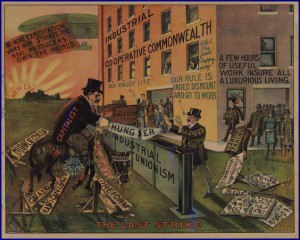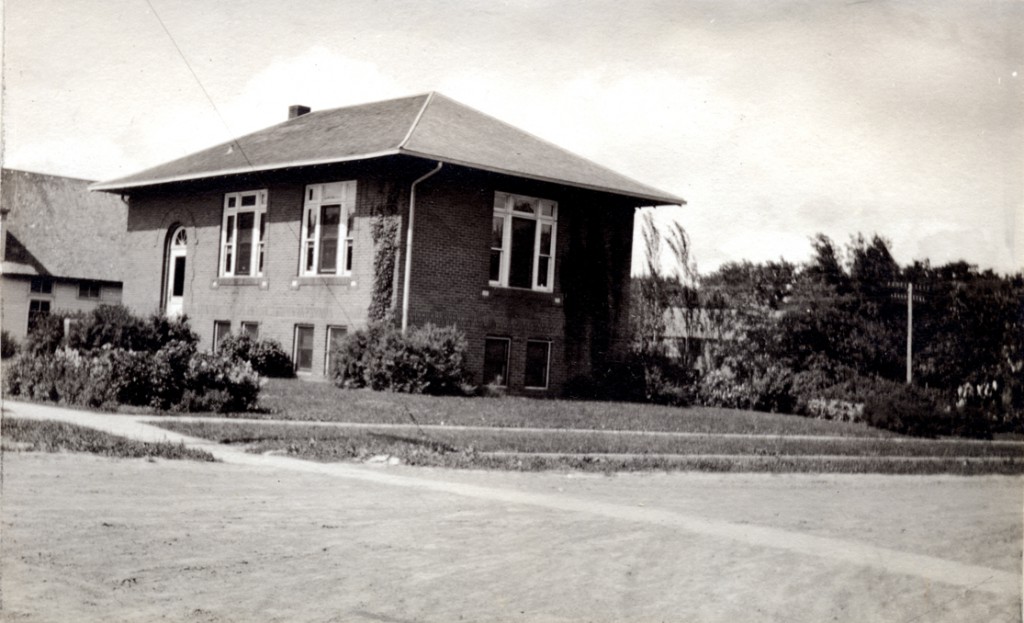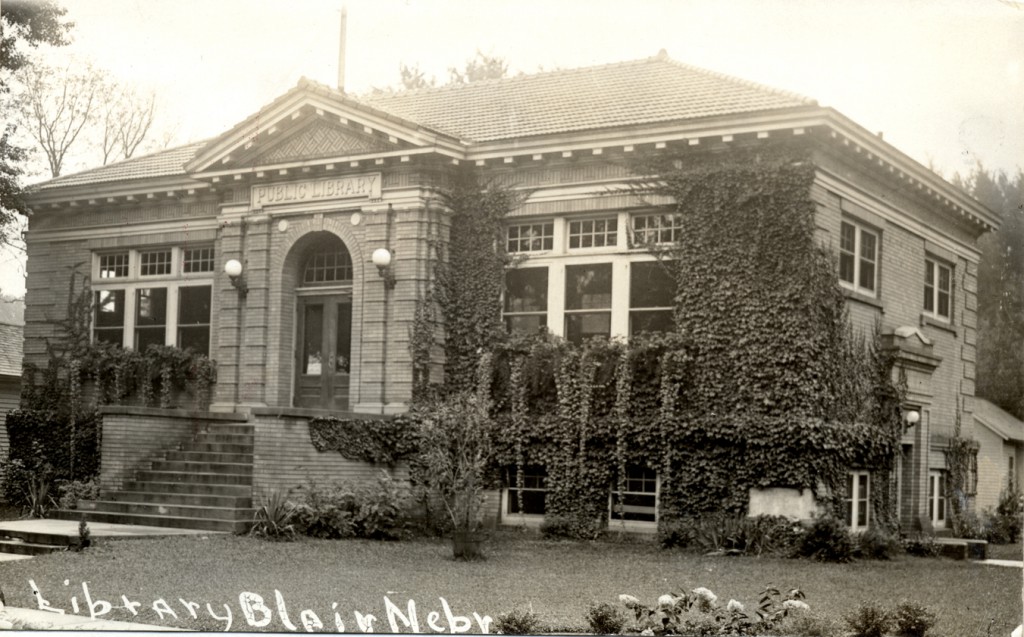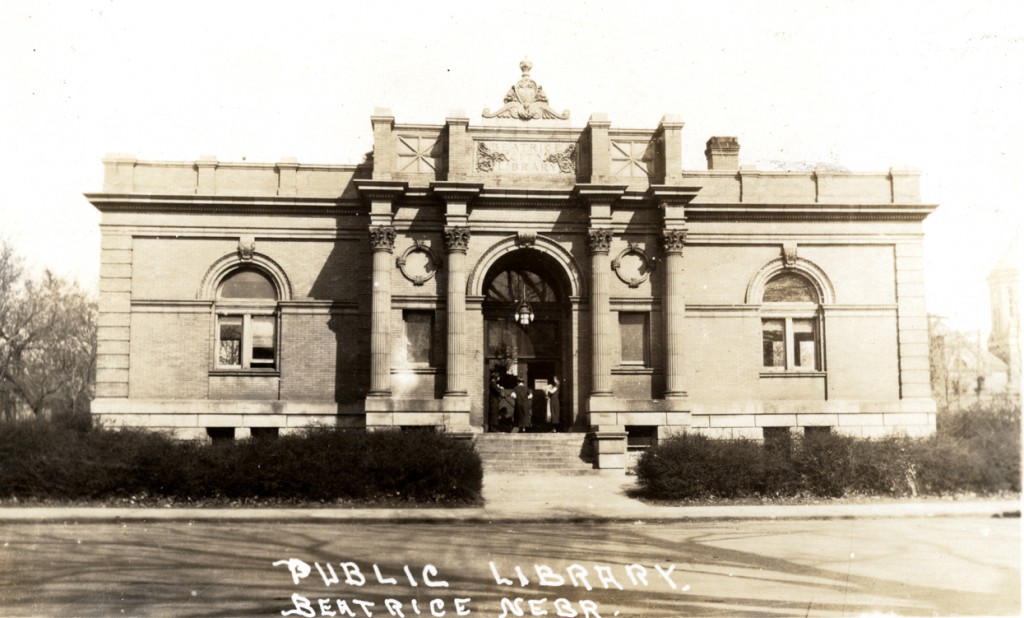Search the Blog
Categories
- Books & Reading
- Broadband Buzz
- Census
- Education & Training
- General
- Grants
- Information Resources
- Library Management
- Nebraska Center for the Book
- Nebraska Memories
- Now hiring @ your library
- Preservation
- Pretty Sweet Tech
- Programming
- Public Library Boards of Trustees
- Public Relations
- Talking Book & Braille Service (TBBS)
- Technology
- Uncategorized
- What's Up Doc / Govdocs
- Youth Services
Archives
Subscribe
Category Archives: General
The Data Dude – Wednesday Watch: John Adams
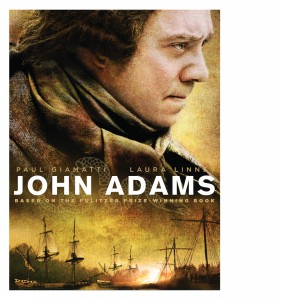 On July 4 in the Dude’s neighborhood, stepping onto the back deck after dark is like stepping onto the set of Apocalypse Now. Every year the Dude goes through this and also uses the time as a friendly reminder to rethink American history. This includes (but is not limited to) such things as the revolutionary war, current events, U.S. Presidents, and of course Native Americans. The Native American part is timely, as the Dude travelled to South Dakota this summer with his two kids for a week long excursion into the hills. It is an oversimplification, but perhaps the notion of early patriotism and American history should always be viewed under the shroud of Native American history. The Dude is in the process of re-watching the excellent PBS series We Shall Remain, a highly recommended tool to help understand early American history from the Native perspective. One word about Mount Rushmore: Its original condition, well known to the Lakota Sioux as Six Grandfathers (yes, the white Dudes renamed it) is spectacular. Unfortunately, there are few photos before it was taken from the Lakota Sioux and carved up, but here is one.
On July 4 in the Dude’s neighborhood, stepping onto the back deck after dark is like stepping onto the set of Apocalypse Now. Every year the Dude goes through this and also uses the time as a friendly reminder to rethink American history. This includes (but is not limited to) such things as the revolutionary war, current events, U.S. Presidents, and of course Native Americans. The Native American part is timely, as the Dude travelled to South Dakota this summer with his two kids for a week long excursion into the hills. It is an oversimplification, but perhaps the notion of early patriotism and American history should always be viewed under the shroud of Native American history. The Dude is in the process of re-watching the excellent PBS series We Shall Remain, a highly recommended tool to help understand early American history from the Native perspective. One word about Mount Rushmore: Its original condition, well known to the Lakota Sioux as Six Grandfathers (yes, the white Dudes renamed it) is spectacular. Unfortunately, there are few photos before it was taken from the Lakota Sioux and carved up, but here is one.
Speaking of July 4 (the Dude will return to the Native tangent later), what about July 2? On July 3, 1776, John Adams wrote a letter to his wife Abigail, about the historical significance of July 2:
“But the Day is past. The Second Day of July 1776, will be the most memorable Epocha, in the History of America. I am apt to believe that it will be celebrated, by succeeding Generations, as the great anniversary Festival. It ought to be commemorated, as the Day of Deliverance by solemn Acts of Devotion to God Almighty. It ought to be solemnized with Pomp and Parade, with Shews, Games, Sports, Guns, Bells, Bonfires and Illuminations from one End of this Continent to the other from this Time forward forever more.”
Many of you may know about the July 2/July 4 confusion, mostly created as a result of John Trumbull’s infamous painting in the U.S. Capitol Rotunda (and also on the back of the $2 bill), Declaration of Independence. The problem with the well-known painting is that it seems to suggest that the Continental Congress event took place on July 4 instead of July 2, and that there was a meeting of the minds and grand signing ceremony on that day. it didn’t happen like that. While the meeting of the minds part (and the vote for independence) took place on July 2, the document itself was revised a bit and finished with a July 4 date, and then sent to the printer. Most of the Independence Dudes skedaddled back home and actually signed the finished Declaration on August 2.
Out of the first 12 Presidents, Adams and Quincy Adams were the only 2 Dudes that not only did not own slaves, but were outspoken against slavery. Washington, for the record, spoke out against slavery, but that apparently didn’t keep him from owning them. But we need to not lose touch with the fact that both Adams and Qunicy Adams were politicians, and should judge accordingly. Also, we need to understand the dynamic between the Colonists and Native Americans. There is little that has been written about the views of Adams when it comes to Native Americans, and little written by Adams himself on the subject. While the Dude would like to speculate that the likes of Adams, Washington et. al. would be appalled at the trail of genocide, broken treaties, and overall lousy treatment of the Native Peoples, the reality is that there is a deep history and support of Native American discrimination, dispossession, and stereotypes (the Declaration of Independence, authored mostly by Jefferson, Adams, and Franklin, includes the phrase “merciless Indian Savages”) that still continues today. Suffice it to say that a balanced view of history is a cogent prescription when it comes to Native Americans. An example of balance might include the Native American art of David Behrens. One of his paintings, an antithesis to Mount Rushmore, is entitled Founding Fathers, a depiction of Chief Joseph, Sitting Bull, Geronimo, and Red Cloud. Alas, this is a tangent that the Dude often goes down, but in this case worth mentioning for the big picture.
Given the Dude’s penchant for often preferring the film or miniseries over the book (although my most recent example of the opposite is evidenced by the lackluster film version of (yawn) Unbroken), most of you know (in case you missed it in the title) that the Dude is through the detours and headed toward the HBO miniseries John Adams for today’s Wednesday Watch.
John Adams is a 7 part series roughly covering 1770-1826, or the time period from the Boston massacre to the death of Adams (ironically on July 4, 1826, the same day that his rival turned pen pal Thomas Jefferson died). According to WorldCat, there are 18 public libraries in Nebraska that have John Adams. The look and feel of the series seems historically accurate. This includes the colonial clothing, characters (Washington, Franklin, Hancock, Hamilton, et. al.), buildings, speech, and the like. The Dude was at first skeptical of actor Paul Giamatti’s depiction of Adams, but by the end of the first episode concluded that Giamatti (the pinot noir wine snob from Sideways) was a good choice. You need to keep in mind that there may be some editorial license taken with the series (it is TV), but there are many historical accuracies and many things to like about it. An example is that it doesn’t sugarcoat the family struggles and dynamic of the Adams family, including John’s absences and Abigail’s difficulties at home. This includes the alcoholism, financial struggles, and premature death of their second son Charles Adams.
Now, if you are looking for a more in depth analysis of the politics or something that has 100% accuracy (if there is such a thing), then you probably want to delve deeper somewhere else. But for understanding the basics (in an easy to digest format) of not only Adams but also many things about the American revolution that you might not have already known, this is a very good start. Some things the Dude wasn’t aware of include the fact that attorney John Adams not only represented the British soldiers charged with murder in the Boston massacre, but got them acquitted. While the portrayal of Samuel Adams (no relation to the beer) as Sonny Corleone-ish seems a bit off (although it adds to the drama), there is much to like with this series. Finally, the Dude would like to thank HBO, who not only responded (the same day no less) to e-mail requests to use the cover art in this and other Wednesday Watch posts, but granted permission. Shaka, HBO.
Posted in General, Uncategorized
Leave a comment
Nebraska 125 Years Ago – Part 2
In my blog post last week I talked about Nebraska 125 years ago and want to continue with that topic. This week we will take a look at the towns of Fremont, Brainard, Fairmont, Bertrand and Sidney.
 Fremont was still a relatively small town with a population of just 1,195. It 1890 it was only 19 years old as it was founded in 1871. Looking at the photo of the Zach Shed residence however it appears that they had some very nice looking houses in town at that time. The Shed residence is ornate as it was built in the Gothic Revival style. While the streets appear to be dirt, the sidewalk surrounding the house is wood. The wood sidewalks even appear to continue across the street.
Fremont was still a relatively small town with a population of just 1,195. It 1890 it was only 19 years old as it was founded in 1871. Looking at the photo of the Zach Shed residence however it appears that they had some very nice looking houses in town at that time. The Shed residence is ornate as it was built in the Gothic Revival style. While the streets appear to be dirt, the sidewalk surrounding the house is wood. The wood sidewalks even appear to continue across the street.
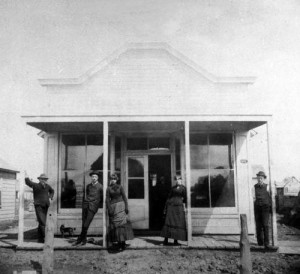 Brainard is just a few years younger than Fremont as it was settled in 1878. The population of Brainard appears to have remained fairly steady over time. In 1890 the population was 306. According to the 2010 Census the population of Brainard was 330. The Smersh Hardware store was established in town on 1884 by Jakub Smersh. While we don’t know the names of the gentlemen standing in front of the store, I would like to think one of the nicely dressed men in a suit, tie and hat is Jakub.
Brainard is just a few years younger than Fremont as it was settled in 1878. The population of Brainard appears to have remained fairly steady over time. In 1890 the population was 306. According to the 2010 Census the population of Brainard was 330. The Smersh Hardware store was established in town on 1884 by Jakub Smersh. While we don’t know the names of the gentlemen standing in front of the store, I would like to think one of the nicely dressed men in a suit, tie and hat is Jakub.
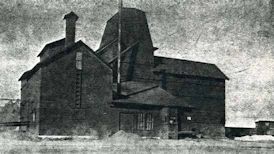 The town of Fairmont appears to have been prosperous in 1890 as it was able to support the Price elevator. At the time the population of town was 1,029. According to the note of the photo the Price elevator stood on the site of the present day elevator in town. The Farmers Cooperative Association purchased the elevator in 1919.
The town of Fairmont appears to have been prosperous in 1890 as it was able to support the Price elevator. At the time the population of town was 1,029. According to the note of the photo the Price elevator stood on the site of the present day elevator in town. The Farmers Cooperative Association purchased the elevator in 1919.
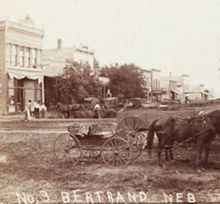 The 1890 photo of Eichelberger store on Main Street, Bertrand, Nebraska provides us with a great view of downtown. For a town of just 265 people it appears to have a large and active main street.
The 1890 photo of Eichelberger store on Main Street, Bertrand, Nebraska provides us with a great view of downtown. For a town of just 265 people it appears to have a large and active main street.
Rose Street in Sidney also appears to be very busy in 1890. Sidney is the oldest of the five towns I’ve mentioned. It was founded in 1867. Looking at the picture of the west side of Rose Street you can see many different types of businesses including multiple grocery stores, a restaurant, arcade, and a meat market. 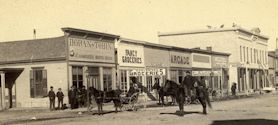 You could even stop in to Doran & Tobin for a beer as their sign clearly states that they are “agents for Anheuser Busch Beer”.
You could even stop in to Doran & Tobin for a beer as their sign clearly states that they are “agents for Anheuser Busch Beer”.
I hope you enjoyed seeing what Nebraska was like 125 years ago. Visit Nebraska Memories to search for or browse through many more historical images digitized from photographs, negatives, postcards, maps, lantern slides, books and other materials.
Nebraska Memories is a cooperative project to digitize Nebraska-related historical and cultural heritage materials and make them available to researchers of all ages via the Internet. Nebraska Memories is brought to you by the Nebraska Library Commission. If your institution is interested in participating in Nebraska Memories, see http://nlc.nebraska.gov/nebraskamemories/participation.aspx for more information, contact Devra Dragos, Technology & Access Services Director.
Posted in General, Nebraska Memories, Technology
Leave a comment
Throwback Thursday: Broken Bow Carnegie Library
Posted in General, Nebraska Memories
Leave a comment
New Online Archive of Historical Political Posters
If you like archives of historical images, you’ll enjoy this newly-available collection of them from the University of Michigan’s Labadie Collection. It features striking political posters from many cultures. A great resource for the researcher, armchair historian, politico, or graphic art fan.
Read the university’s description of the archive here.
More details about the picture above are here.
Posted in General
Leave a comment
The Data Dude – Early Literacy
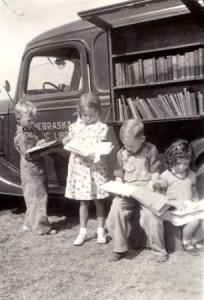 Believe it or not, the Dude is working on next year’s public library survey, scheduled to launch around mid-November, 2015. And to those of you who I promised no major changes, I apologize. There will be changes and some will be major. Some will be minor. Before you get bent out of shape, let me explain that some of the major changes will be for the better; clarifying some things that were difficult to understand in the past, pre-filling more data to help you with the survey, and hopefully make your life a bit easier during survey time. For today’s post, the focus is something the Dude read on early literacy; specifically the well known library program called 1,000 Books Before Kindergarten. Many Nebraska libraries offer this program. It’s generally thought to be a passive library program, but nonetheless, you can count it as a children’s program on your survey. If you are looking for more information about the program, read this article about three-year olds Gidget and Jaycee Crocker, from McCook, Nebraska. Most would agree that these are good programs, helping to promote early literacy and familial connections. However, we have no data on these types of early literacy programs. On the next survey, you will be asked how many children’s programs are specifically focused on early learning and literacy (pre-K)? And remember, while we would like you to collect and report the data, if you simply don’t have it this year because you have not yet implemented a mechanism for counting, you can look to the minus 1 (-1), which is entered when the data is not available or not collected. Now, as the Dude pointed out before, the minus 1 isn’t always the desired answer, but sometimes it is the best one. Shaka.
Believe it or not, the Dude is working on next year’s public library survey, scheduled to launch around mid-November, 2015. And to those of you who I promised no major changes, I apologize. There will be changes and some will be major. Some will be minor. Before you get bent out of shape, let me explain that some of the major changes will be for the better; clarifying some things that were difficult to understand in the past, pre-filling more data to help you with the survey, and hopefully make your life a bit easier during survey time. For today’s post, the focus is something the Dude read on early literacy; specifically the well known library program called 1,000 Books Before Kindergarten. Many Nebraska libraries offer this program. It’s generally thought to be a passive library program, but nonetheless, you can count it as a children’s program on your survey. If you are looking for more information about the program, read this article about three-year olds Gidget and Jaycee Crocker, from McCook, Nebraska. Most would agree that these are good programs, helping to promote early literacy and familial connections. However, we have no data on these types of early literacy programs. On the next survey, you will be asked how many children’s programs are specifically focused on early learning and literacy (pre-K)? And remember, while we would like you to collect and report the data, if you simply don’t have it this year because you have not yet implemented a mechanism for counting, you can look to the minus 1 (-1), which is entered when the data is not available or not collected. Now, as the Dude pointed out before, the minus 1 isn’t always the desired answer, but sometimes it is the best one. Shaka.
Posted in General, Information Resources, Library Management, Uncategorized
1 Comment
Free Immigration Webinar
 On July 2, 2015, the Institute of Museum and Library Services (IMLS) and U.S. Citizenship and Immigration Services (USCIS) will host a free webinar for public librarians on the topic of immigration and U.S. citizenship. Join in to learn more about what resources are available to assist libraries in providing immigrant and adult education services. The webinar, Overview of myE-Verify, will explore a new online service for the general public. Representatives will be on hand to discuss how the service can be used to:
On July 2, 2015, the Institute of Museum and Library Services (IMLS) and U.S. Citizenship and Immigration Services (USCIS) will host a free webinar for public librarians on the topic of immigration and U.S. citizenship. Join in to learn more about what resources are available to assist libraries in providing immigrant and adult education services. The webinar, Overview of myE-Verify, will explore a new online service for the general public. Representatives will be on hand to discuss how the service can be used to:
- Confirm their work eligibility with Self Check
- Create a myE-Verify account
- Protect their Social Security number in E-Verify with Self Lock
- Access myResources, a multimedia resource center to learn about their rights and their employer’s responsibilities.
Webinar Details:
Date: July 2, 2015
Time: 2:00 – 3:00 p.m. EDT
Click here to register
This series was developed as part of a partnership between IMLS and USCIS to ensure that librarians have the necessary tools and knowledge to refer their patrons to accurate and reliable sources of information on immigration-related topics. To find out more about the partnership and the webinar series, visit the Serving New Americans page of the IMLS website or on the USCIS website.
Throwback Thursday: Bloomfield Carnegie Library
Posted in General, Nebraska Memories
Leave a comment
The Data Dude – IMLS Compare Tool
 IMLS has recently updated the Compare Public Libraries and Search for Public Libraries tools with FY 2013 data. If you are looking for Nebraska library data, the best place is on the NLC website, in the data services section. Those statistical reports are available back to 1999. However, you might think that the Compare tool is a bit less relevant because it has FY 2013 data instead of the FY2014 Nebraska data. Keep in mind that IMLS has different groups of states that have different public library survey submission dates (so that all 50 states – plus U.S. territories) aren’t being submitted at the same time. The Compare tool is a great tool. It is easy to learn how to use and navigate just by operating it. One thing of importance is that this tool is valuable to identify your national peers. The Compare tool allows you to generate a report based on the factors reported in the survey, but one important one is the legal service population (LSA) of your library. To do this, first begin your search by finding your library. Next, click on “Choose Similar Libraries (Comparison Group) by Variable”. You can select any variable, but if you want LSA, click on the + sign next to Organizational Characteristics, then Population of Legal Service Area. I like Method 1, which defaults to 20%, but depending on your library a more realistic percentage is 5% or 3%. The Compare tool will then tell you how many libraries are in your comparison group. You can either add another variable, or if you just want the data for those libraries, click on Continue. On the next screen, expand each category you want data for (or you can select all of them). You can then look at the data from the libraries in your comparison group, or export it to an excel file from the link at the top. Shaka.
IMLS has recently updated the Compare Public Libraries and Search for Public Libraries tools with FY 2013 data. If you are looking for Nebraska library data, the best place is on the NLC website, in the data services section. Those statistical reports are available back to 1999. However, you might think that the Compare tool is a bit less relevant because it has FY 2013 data instead of the FY2014 Nebraska data. Keep in mind that IMLS has different groups of states that have different public library survey submission dates (so that all 50 states – plus U.S. territories) aren’t being submitted at the same time. The Compare tool is a great tool. It is easy to learn how to use and navigate just by operating it. One thing of importance is that this tool is valuable to identify your national peers. The Compare tool allows you to generate a report based on the factors reported in the survey, but one important one is the legal service population (LSA) of your library. To do this, first begin your search by finding your library. Next, click on “Choose Similar Libraries (Comparison Group) by Variable”. You can select any variable, but if you want LSA, click on the + sign next to Organizational Characteristics, then Population of Legal Service Area. I like Method 1, which defaults to 20%, but depending on your library a more realistic percentage is 5% or 3%. The Compare tool will then tell you how many libraries are in your comparison group. You can either add another variable, or if you just want the data for those libraries, click on Continue. On the next screen, expand each category you want data for (or you can select all of them). You can then look at the data from the libraries in your comparison group, or export it to an excel file from the link at the top. Shaka.
Nebraska 125 Years Ago – Part 1
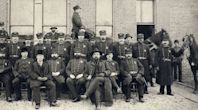 The year was 1890 and Nebraska had officially been a state for 23 years. John Milton Thayer was Governor. The population of the state was 1.062 million but the population of Lincoln was just 55,154. Lincoln was being protected by Chief Melick and his fellow Lincoln police officers.
The year was 1890 and Nebraska had officially been a state for 23 years. John Milton Thayer was Governor. The population of the state was 1.062 million but the population of Lincoln was just 55,154. Lincoln was being protected by Chief Melick and his fellow Lincoln police officers.
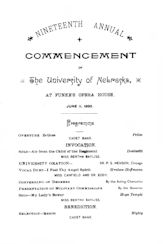 The University of Nebraska held their Nineteenth annual commencement on June 11, 1890. The commencement was held at Funke’s Opera House which was located at the corner of 12th & O Streets in Lincoln. It had formerly been called Hallo’s Opera House and then Centennial Opera House. According to the commencement program the Governor attended the ceremony to present the military commissions.
The University of Nebraska held their Nineteenth annual commencement on June 11, 1890. The commencement was held at Funke’s Opera House which was located at the corner of 12th & O Streets in Lincoln. It had formerly been called Hallo’s Opera House and then Centennial Opera House. According to the commencement program the Governor attended the ceremony to present the military commissions.
 Omaha was also a lot smaller in 1890 with a population of 140,452. The city had a number of paved streets at this time as can be seen on this 1890 Paving map of Omaha, Nebraska. To get a better idea of the physical size of Omaha I studied the map looking for landmarks that are still present 125 years later. The east side of Omaha of course is easy to identify. On the North half of the map Cut Off Lake is clearly marked. If you don’t recognize that lake it may be because in 1906 the name was changed to Carter Lake. On the South half of the map the Missouri River is clearly marked. The northern edge of town is also fairly easy to identify. Towards the top of the North half of the map you can clearly see Fort Omaha. It’s located near where the top fold line and middle fold line on the map cross.
Omaha was also a lot smaller in 1890 with a population of 140,452. The city had a number of paved streets at this time as can be seen on this 1890 Paving map of Omaha, Nebraska. To get a better idea of the physical size of Omaha I studied the map looking for landmarks that are still present 125 years later. The east side of Omaha of course is easy to identify. On the North half of the map Cut Off Lake is clearly marked. If you don’t recognize that lake it may be because in 1906 the name was changed to Carter Lake. On the South half of the map the Missouri River is clearly marked. The northern edge of town is also fairly easy to identify. Towards the top of the North half of the map you can clearly see Fort Omaha. It’s located near where the top fold line and middle fold line on the map cross.
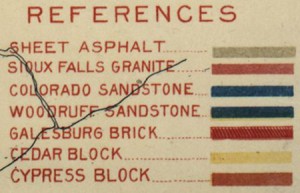 The south edge of town is also easy to identify. On the bottom right corner of the South half of the map is River View Park. If you don’t know the history of River View Park it is now the location of the Henry Doorly Zoo. Locating a present day landmark on the far west side of Omaha wasn’t as easy. Looking at the map you will see that there are very few of the north south streets are named and when are named they don’t always match up with current street names. On the South half of the map Hanscom Park is located at about the center of the map. The west side of the park runs along 32nd Ave. I’m guessing the west side of town ends around what is now 50th street.
The south edge of town is also easy to identify. On the bottom right corner of the South half of the map is River View Park. If you don’t know the history of River View Park it is now the location of the Henry Doorly Zoo. Locating a present day landmark on the far west side of Omaha wasn’t as easy. Looking at the map you will see that there are very few of the north south streets are named and when are named they don’t always match up with current street names. On the South half of the map Hanscom Park is located at about the center of the map. The west side of the park runs along 32nd Ave. I’m guessing the west side of town ends around what is now 50th street.
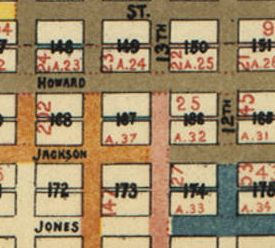 Looking at the map you can see that the streets of Omaha in 1890 were paved with a variety of different materials, including sheet asphalt, Sioux Falls granite, Colorado sandstone, Woodruff sandstone, Galesburg brick, cedar block, and cypress block. Looking at the area of 13th and Jones Street you can see that a variety of these options were used in this area. While the map does not label individual stores we know that Henry Moeller’s grocery store was located on the northwest corner of 13th and Jones.
Looking at the map you can see that the streets of Omaha in 1890 were paved with a variety of different materials, including sheet asphalt, Sioux Falls granite, Colorado sandstone, Woodruff sandstone, Galesburg brick, cedar block, and cypress block. Looking at the area of 13th and Jones Street you can see that a variety of these options were used in this area. While the map does not label individual stores we know that Henry Moeller’s grocery store was located on the northwest corner of 13th and Jones.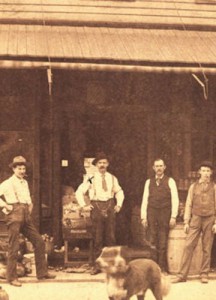 Looking at the picture I think the store faced Jones Street but unfortunately I can’t tell if that is Sioux Falls granite in front of the store.
Looking at the picture I think the store faced Jones Street but unfortunately I can’t tell if that is Sioux Falls granite in front of the store.
Watch for Nebraska 125 Years Ago, Part 2 next week to see more of Nebraska and what it looked in 1890.
Visit Nebraska Memories to search for or browse through many more historical images digitized from photographs, negatives, postcards, maps, lantern slides, books and other materials.
Nebraska Memories is a cooperative project to digitize Nebraska-related historical and cultural heritage materials and make them available to researchers of all ages via the Internet. Nebraska Memories is brought to you by the Nebraska Library Commission. If your institution is interested in participating in Nebraska Memories, see http://nlc.nebraska.gov/nebraskamemories/participation.aspx for more information, contact Devra Dragos, Technology & Access Services Director.
Posted in General, Nebraska Memories, Technology
Leave a comment
Friday Reads: Big Bad Love by Larry Brown
 Two of my favorite authors are Raymond Carver and Charles Bukowski. Both are blue collar writers who encapsulate the mundane, disturbing, hapless, and tragic parts of everyday lives. Often, there is a great deal of humor underneath or simultaneously with these tragedies. Until recently, I had no idea that there is a term for this style and type of writing. It’s called “dirty realism.” The writing focuses more on the pain and suffering rather than the warm and fuzzy; the unhappiness rather than the happy; the trivial rather than the substantive. Both Carver and Bukowski have a very distinctive L.A. feel; although Bukowski was more skid row than Carver. Listen to some Tom Waits while you read either and you’ll feel right at home (I’d recommend Frank’s Wild Years and/or Swordfishtrombones). Now, before I get to rambling (or to put an end to it here and now), this Friday Reads isn’t about Carver or Bukowski. The problem is that I’ve already read their stuff (they are both dead), and for years have been searching for something with a similar feel. I finally found it when I discovered Larry Brown. Unfortunately, Larry Brown also died in 2004, but since I have yet to read any of his stuff, I feel refreshed. Well, sort of.
Two of my favorite authors are Raymond Carver and Charles Bukowski. Both are blue collar writers who encapsulate the mundane, disturbing, hapless, and tragic parts of everyday lives. Often, there is a great deal of humor underneath or simultaneously with these tragedies. Until recently, I had no idea that there is a term for this style and type of writing. It’s called “dirty realism.” The writing focuses more on the pain and suffering rather than the warm and fuzzy; the unhappiness rather than the happy; the trivial rather than the substantive. Both Carver and Bukowski have a very distinctive L.A. feel; although Bukowski was more skid row than Carver. Listen to some Tom Waits while you read either and you’ll feel right at home (I’d recommend Frank’s Wild Years and/or Swordfishtrombones). Now, before I get to rambling (or to put an end to it here and now), this Friday Reads isn’t about Carver or Bukowski. The problem is that I’ve already read their stuff (they are both dead), and for years have been searching for something with a similar feel. I finally found it when I discovered Larry Brown. Unfortunately, Larry Brown also died in 2004, but since I have yet to read any of his stuff, I feel refreshed. Well, sort of.
Like much (if not all) of Carver’s work, Larry Brown’s Big Bad Love is a collection of short stories. There are similarities, but Brown lived in Oxford, Mississippi, so the stories have a different, non-California feel to them. The stories are written from a male perspective, filled with alcoholics, depression, and tales of dysfunctional or failed relationships. I found the stores to be relatable (on some levels) and often hilarious. There is, however, a fine line between laughing at another’s misery and laughing with them. I had the latter feeling. There is something to say about retaining your sense of humor during life’s tragedies, and I think Brown aptly captures that, at least in part 1. Part 2 of the book consists of a longer story. I wouldn’t even recommend reading it. Compared to part 1, it’s a bore. Here’s a quote from part 1 that provides a snippet of Brown’s style:
“I didn’t know why something that started off feeling so good had to wind up feeling so bad. Love was a big word and it covered a lot of territory. You could spend your whole life chasing after it and wind up with nothing, be an old bitter guy with long nose hair and ear hair and no teeth, hanging out in bars, looking for somebody your age, but the chances of success went down then. After a while you got too many strikes against you.”
Focus on Nebraska authors: Jonis Agee
Omaha native Jonis Agee grew up in Nebraska and Missouri so they are often the settings for her novels. The New York Times Book Review called her “a gifted poet of that dark lushness in the heart of the American landscape.” She is a Professor of English at the University of Nebraska-Lincoln and teaches creative writing and twentieth-century fiction. She earned her BA at the University of Iowa and her MA and PhD from the State University of New York at Binghamton.
Jonis has been awarded two Nebraska Book Awards for The Weight of Dreams and Acts of Love on Indigo Road and three of her books — Strange Angels, Bend This Heart, and Sweet Eyes — were named Notable Books of the Year by The New York Times. She is the co-writer, with her husband Brent Spencer, of the screenplays Full Throttle, Baghdad Rules and Everlasting. Together they live on a small acreage north of Omaha in Ponca Hills. Of her five novels four are included in our book club collection: The River Wife, Strange Angels, Sweet Eyes, and Weight of Dreams. In each she creates a strong sense of Midwestern place alongside compelling family dramas laced with grit. Please consider selecting one of Agee’s titles for your next book club selection.
Posted in Books & Reading, General, Information Resources
Leave a comment
GROW Nebraska Workshop July 2
 Omaha’s SCORE chapter will host GROW Nebraska for an informative small business workshop Thursday, July 2, from 9:30 a.m. to 11:30 a.m. at the SBA Nebraska District Office, 10675 Bedford Avenue, Suite 100, Omaha. Janell Ehrke, CEO of GROW Nebraska, will explain how the non-profit organization connects entrepreneurs to the world marketplace.
Omaha’s SCORE chapter will host GROW Nebraska for an informative small business workshop Thursday, July 2, from 9:30 a.m. to 11:30 a.m. at the SBA Nebraska District Office, 10675 Bedford Avenue, Suite 100, Omaha. Janell Ehrke, CEO of GROW Nebraska, will explain how the non-profit organization connects entrepreneurs to the world marketplace.
GROW Nebraska provides entrepreneurial coaching and market access opportunities to its members, creating sustainable economic development for more than 350 small business members through promotions, market access and education. They offer more than 20 services, including initial consultations, counseling, product evaluation, and are on the cutting edge of social media marketing training.
GROW Nebraska also allows members to choose to participate in everything the organization offers, or just pay only for low-cost services that best suit them. Instead of forcing one-size-fits-all approaches on each small business client, GROW encourages its members to develop a plan that benefits their business the most.
There is no charge for the workshop, but please register by calling Marilyn Riley at the SCORE office at 402-221-3606 or email score@scoreomaha.org, as space is limited.
The Data Dude – Robots in the Library Makerspace
 The Dude has been on vacation (and after travelling with two kids ages 4 and 8, discovered that there are some pretty decent shows on Cartoon Network—favorites include Uncle Grandpa, the Regular Show, Steven Universe, and Teen Titans Go!), but wanted to share an article about the Westport Public Library in Westport, Connecticut. Two things caught the Dude’s attention: (1) The robust makerspace at this library – specifically, the acquisition and availability of robots; and (2) the possibilities for programming these robots, as evidenced by their Tai Chi demonstration. For the record, the Dude is a student of Chen style Tai Chi; it looks like the robots are programmed to do some type of Yang style. It’s not that one is necessarily better than the other, but there are differences. Nonetheless, it interestingly illustrates what can be done in this library’s makerspace. The draw to the robots is similar to the idea of libraries offering the CoderDojo, except in this instance you are programming the robot and not websites, games, and apps. These robots can speak 19 different languages. If you are considering expanding your makerspace offerings, check out the makerspace section of Westport’s website, complete with videos and a blog. Shaka.
The Dude has been on vacation (and after travelling with two kids ages 4 and 8, discovered that there are some pretty decent shows on Cartoon Network—favorites include Uncle Grandpa, the Regular Show, Steven Universe, and Teen Titans Go!), but wanted to share an article about the Westport Public Library in Westport, Connecticut. Two things caught the Dude’s attention: (1) The robust makerspace at this library – specifically, the acquisition and availability of robots; and (2) the possibilities for programming these robots, as evidenced by their Tai Chi demonstration. For the record, the Dude is a student of Chen style Tai Chi; it looks like the robots are programmed to do some type of Yang style. It’s not that one is necessarily better than the other, but there are differences. Nonetheless, it interestingly illustrates what can be done in this library’s makerspace. The draw to the robots is similar to the idea of libraries offering the CoderDojo, except in this instance you are programming the robot and not websites, games, and apps. These robots can speak 19 different languages. If you are considering expanding your makerspace offerings, check out the makerspace section of Westport’s website, complete with videos and a blog. Shaka.
Photo courtesy of Westport Public Library, Westport, CT.
What’s Sally Reading?
 Get to Know the Nominees for Teens’ Top Ten 2015
Get to Know the Nominees for Teens’ Top Ten 2015
The Hub has begun a four-part The Hub to highlight the 24 titles on the Teens’ Top Ten list for 2015. The books were published between January 1, 2014 and December 31, 2014. You can see the entire list here if you want to check and see how many your library owns. Teens from all over the country can vote for their favorite title beginning on August 15, 2015 and continue through Teen Read Week (October 18-24, 2015). The ten titles receiving the most votes will be named the Teens’ Top Ten list for 2015. I hope your teens will want to participate!
 Castle Hangnail by Ursula Vernon, who wrote the Dragonbreath series, introduces readers to new characters and setting, which could become a series as well. Castle Hangnail has been without a master for far too long, and the main caretaker is worried it will be decommissioned. Then Miss Molly, a 12-year-old witch arrives to claim the castle. She does have an invitation (one of many sent out) but she seems so unorthodox, she’s nice (usually) and considerate, but she can do some magic. She has four tasks to complete in order to claim the castle, maybe everything will work out. Then, the sorceress who was the actual recipient of the invitation appears at the door; and she is nasty, just as the master of the castle should be. But the minions in the castle rather like Miss Molly, what should they do?
Castle Hangnail by Ursula Vernon, who wrote the Dragonbreath series, introduces readers to new characters and setting, which could become a series as well. Castle Hangnail has been without a master for far too long, and the main caretaker is worried it will be decommissioned. Then Miss Molly, a 12-year-old witch arrives to claim the castle. She does have an invitation (one of many sent out) but she seems so unorthodox, she’s nice (usually) and considerate, but she can do some magic. She has four tasks to complete in order to claim the castle, maybe everything will work out. Then, the sorceress who was the actual recipient of the invitation appears at the door; and she is nasty, just as the master of the castle should be. But the minions in the castle rather like Miss Molly, what should they do?
(The Nebraska Library Commission receives free copies of children’s and young adult books for review from a number of publishers. After review, the books are distributed free, via the Regional Library Systems, to Nebraska school and public libraries.)
Posted in Books & Reading, General, Youth Services
Leave a comment
The Data Dude – Wednesday Watch – Rectify
 Recently, one of the Dude’s colleagues here at the Commission conveyed a quote from Oscar Aviles, the warden for the Hudson County, NJ jail. Warden Aviles used to believe that his job was limited to keeping the jail safe; regarding rehabilitation and re-entry programs for inmates, he said: “That’s not my problem. This is somebody else’s problem.” He no longer thinks this way. In other institutions, the end of this line of thinking is long overdue. The Dude thinks libraries have the potential to play a large and important role in that (and are often underutilized by administrators).
Recently, one of the Dude’s colleagues here at the Commission conveyed a quote from Oscar Aviles, the warden for the Hudson County, NJ jail. Warden Aviles used to believe that his job was limited to keeping the jail safe; regarding rehabilitation and re-entry programs for inmates, he said: “That’s not my problem. This is somebody else’s problem.” He no longer thinks this way. In other institutions, the end of this line of thinking is long overdue. The Dude thinks libraries have the potential to play a large and important role in that (and are often underutilized by administrators).
Those of you who know the Dude are aware that he used to work in a correctional facility library. During the time there, the Dude had an inmate who worked with him for almost the entire 9 years. This particular guy told the Dude about an original series show on Sundance TV (owned by AMC Networks) called Rectify. Now, don’t get this confused with Justify. The sound alike, but are two entirely different animals. Justify is a show on FX starring Timothy Olyphant (who also played Sheriff Seth Bullock in the fantastic HBO series Deadwood). In Justify, Olyphant plays Raylan Givens, a no-nonsense U.S. Marshall who returns to his hometown in Kentucky. It’s a sound series, but today’s column is about Rectify. Anyway, this particular inmate told the Dude that by far Rectify absolutely nails the feeling that a person has when they are released from prison. The story of Rectify begins with the main character, Daniel Holden (played by Aden Young) being released from Georgia’s death row after 19 years. He went to death row at the age of 18 for the rape and murder of his 16 year old girlfriend. He confessed to the crime, but there is a lot of doubt about whether or not the confession was coerced. DNA evidence frees him from death row, but it doesn’t necessarily exonerate him. Many in the local community still believe he is guilty, and as the viewer, we really don’t know (at least after two seasons). The first six episodes cover the first six days after his release from prison. Flashbacks tell part of the story of the days during his incarceration. The main thing about Rectify, the thing that the inmate who worked with me in the library wanted to convey, is that it appropriately captures some of the experiences and struggles of prison life, and also the huge challenges of transition back into society (especially after being locked up for 19 years). The subplot (although as the series develops it becomes more and more relevant) is finding out what actually happened on the night of the murder, and the depth of the involvement of the main character, Daniel Holden. But that really is a subplot, at least in the first two seasons.
You might look at the summary of Rectify and believe it’s just another ho-hum cliché of whodunnit, but it is really much more than that. Both season 1 and season 2 are available on DVD. Season 3 is scheduled to begin on July 9, 2015. Since the Dude has no cable, he will need to wait for the DVD or the Netflix streams to get caught up with season 3. According to Firstsearch, no Nebraska libraries (that’s zero, nada) have Rectify on DVD. A number of libraries in neighboring states have it, however, and 289 libraries worldwide. Shaka.
Posted in General, Library Management, Uncategorized
Leave a comment
Simpson’s Sheep Won’t Go to Sleep! to Represent Nebraska at National Book Festival
FOR IMMEDIATE RELEASE: 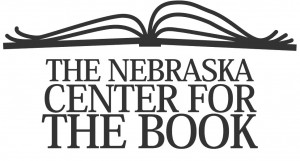
June 9, 2015
FOR MORE INFORMATION:
Mary Jo Ryan
402-471-3434
800-307-2665
Simpson’s Sheep Won’t Go to Sleep! to Represent Nebraska at National Book Festival
The Nebraska Center for the Book selected Simpson’s Sheep Won’t Go to Sleep! by Bruce Arant (Peter Pauper Press, Inc., 2013) to represent Nebraska at the 2015 National Book Festival. The book is the state’s selection for the National Book Festival’s “Discover Great Places through Reading” map. Each state selects one book about the state, or by an author from the state, that is a good read for children or young adults. The map will be distributed at the Festival on September 5 and listed in “Great Reads about Great Places” on the websites of both the National and Nebraska Centers for the Book.
Will poor Farmer Simpson ever find a way to lull his sheep to sleep? Illustrated with soft pastel drawings, Simpson’s Sheep Won’t Go to Sleep! is a story for every parent or grandparent who has put a child to bed—and every child who has creatively resisted. The selection was awarded the 2014 Nebraska Book Award in the Children’s category. NOTE: Entries for the 2015 Nebraska Book Awards will be accepted until June 30—see http://centerforthebook.nebraska.gov/awards/nebookawards.html.
The National Book Festival will feature award-winning authors, poets, and illustrators at the Walter E. Washington Convention Center in Washington, DC. Festival goers can meet their favorite authors, get books signed, have photos taken with mascots and storybook characters, and participate in a variety of learning activities. States will staff exhibit booths to promote reading, library programs, and literary events.
The Nebraska Center for the Book is housed at the Nebraska Library Commission and brings together the state’s readers, writers, booksellers, librarians, publishers, printers, educators, and scholars to build the community of the book, supporting programs to celebrate and stimulate public interest in books, reading, and the written word. The Nebraska Center for the Book is supported by the Nebraska Library Commission. As the state library agency, the Nebraska Library Commission is an advocate for the library and information needs of all Nebraskans. The mission of the Library Commission is statewide promotion, development, and coordination of library and information services, bringing together people and information.
###
The most up-to-date news releases from the Nebraska Library Commission are always available on the Library Commission Website, http://nlc.nebraska.gov/publications/newsreleases.
Posted in Books & Reading, General
Leave a comment
Friday Reads: The Tea Rose Trilogy by Jennifer Donnelly
From Library Journal:
In The Tea Rose, it is “1888, and Fiona Finnegan and Joe Bristow hoard shillings and pennies so that they can marry and open a shop. But Jack the Ripper stalks the streets of London’s East End, and poverty threatens from the shadows. Setting the story in motion is the murder of Fiona’s father, a dock worker whose union activities angered his tea-company boss. Fiona and her younger brother must flee to New York City to avoid their own murders. Through hard work and luck, Fiona and her beloved Joe prosper on opposite sides of the Atlantic. Misunderstandings and mistakes keep them apart as they build separate lives and incredible fortunes. Children’s book writer Donnelly effortlessly takes her narrative through slums and high society while intertwining a number of subplots without tangling them. Both major and minor characters capture and hold interest and sympathy. ”
The Winter Rose, the second book in the Tea Rose Trilogy, begins “in late Victorian London. Idealistic new medical school graduate India Selwyn Jones goes to work at a clinic in the city’s poorest neighborhood, much to the dismay of her aristocratic mother and ambitious fiancé, political up-and-comer Freddie Lytton. The squalor is a bit much for India, but she manages to keep her emotions under control until she meets underworld crime boss Sid Malone. Sid begins as India’s nemesis, becomes her patient and ends up something much more than that. What India doesn’t know is that Sid is the brother of tea heiress Fiona Bristow, wife of self-made, highly principled businessman Joseph Bristow. What Sid doesn’t know is that India’s fiancé is as ruthless as Sid’s most ruthless henchman, willing to commit theft, betrayal and even murder to launch his career, force India out of hers and bring down Sid in the process.”
From Hachette:
In the third Tea Rose Trilogy book, The Wild Rose, “it is London, 1914. World War I looms on the horizon, women are fighting for the right to vote, and explorers are pushing the limits of endurance in the most forbidding corners of the earth. Into this volatile time, Jennifer Donnelly places her vivid and memorable characters: Willa Alden, a passionate mountain climber who lost her leg while summiting Kilimanjaro with Seamus Finnegan, and who will never forgive him for saving her life; Seamus Finnegan, a polar explorer who tries to forget Willa as he marries a beautiful young school teacher back home in England; Max von Brandt, a handsome German sophisticate who courts high society women, but has a secret agenda in wartime London.”
I listened to the audio versions of these books. They are all narrated by Jill Tanner, who does a wonderful job with all of the character’s voices. Whether you read the book, or listen to the audio version, I’m sure you will find this historical fiction saga as enjoyable as I did.
Tracking fees have now been eliminated
Beginning June 1, 2015, Library Mail and Media mail packages sent through the U.S. Postal Service can be tracked for free, as the $1.05 per item tracking fee is being eliminated. All you need to do is ensure a barcoded USPS tracking label is affixed to your mailpiece. Delivery information can be obtained at www.usps.com (using the search box) or call toll-free 1-800-222-1811. Tracking labels can be ordered online at no charge in packs of 50 at this link.
Posted in General, Information Resources
Leave a comment

